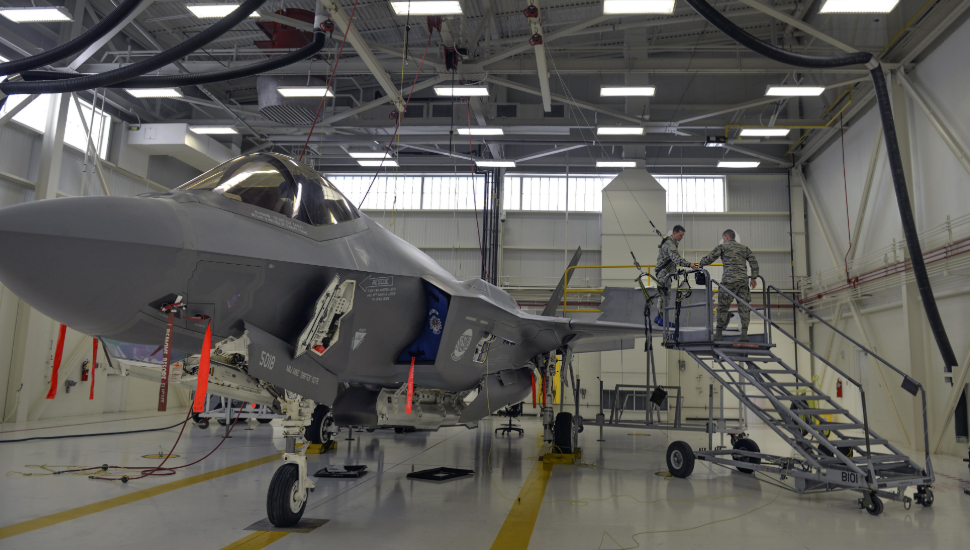The Lockheed Martin F-35 Lightning II’s performance is far lower than desired by the US Department of Defense (DoD), largely due to spare parts shortages, as well as difficulty managing and moving parts around the world.
Only 27% of F-35 fighters worldwide were full mission capable between May and November 2018, according to a study conducted by the Government Accountability Office (GAO). Some 52% of the stealth fighters were mission capable – able to perform at least one mission – over the same period.

F-35A Lightning II undergoing maintenance at Eglin AFB
USAF
The operational F-35 Lightning II fleet should reach an 80% mission capability rate by September 2020, Vice Admiral Mathias Winter, executive officer of the Joint Programme Office (JPO) said in prepared testimony before the US House Armed Services Tactical Air and Land Forces Subcommittee on 4 April. Reaching an 80% mission capability rate was mandated by former Defense Secretary James Mattis for key combat aircraft, including the F-35, Lockheed Martin F-22, Lockheed Martin F-16 and Boeing F/A-18.
Still, F-35 aircraft were unable to fly nearly 30% of the time during the study due to spare parts shortages, according to GAO. The DoD also had a repair backlog of about 4,300 parts.
“DoD is taking steps to fix these issues, such as improving the reliability of parts,” says GAO. “However, it has not fully determined actions needed to close the gap between warfighter requirements and the performance the F-35 supply chain can deliver.”
The F-35 fleet is also suffering from mismatched parts. The DoD purchases certain sets of F-35 parts years ahead of time to support aircraft on deployments, including on US Navy (USN) aircraft carriers and US Marine Corps (USMC) amphibious assault ships. But the parts do not fully match the military services' needs because F-35 aircraft have been modified over time, says the GAO.
“For example, 44% of purchased parts were incompatible with aircraft the Marine Corps took on a recent deployment,” says the GAO. “Without a process to modify the sets of parts for deployments, DoD may be unable to meet the services' operational needs.”
To make matters worse, the DoD has spent billions of dollars on F-35 spare parts, but does not have records for all the parts it has purchased, where they are, or how much they cost.
“For example, DOD is not maintaining a database with information on F-35 parts the US owns, and it lacks the necessary data to be able to do so,” says GAO. “Without a policy that clearly defines how it will keep track of purchased F-35 parts, DoD will continue to operate with a limited understanding of the F-35 spare parts it owns and how they are being managed. If left unaddressed, these accountability issues will impede DOD's ability to obtain sufficient readiness within affordability constraints.”
What’s more, the DoD’s re-supply network for moving F-35 parts around the world is immature, says the accountability agency.
“Overseas F-35 customers have experienced long wait times for parts needed to repair aircraft,” says GAO. “Without a detailed plan for the network, DoD may not be ready to support an expanding fleet.”

Crew member seals an F-35A Lightning II panel at Luke AFB
USAF
Lockheed Martin is the prime contractor responsible for managing the F-35 supply chain, depot maintenance, and pilot and maintainer training, as well as for providing engineering and technical support. Just a week ahead of GAO publishing its report, the company announced that it was trying to improve F-35 parts inventories and reduce sustainment costs by signing more long-term Performance Based Logistics (PBL) contracts.
Under PBL contracts, suppliers are awarded a flat fee to maintain a certain level of performance for a part or subsystem, rather than just supply one-off parts or repair services. The idea is that the supplier will take ownership of the subsystem, working to meet the agreed upon performance metric, while driving out inefficiencies, to keep money saved for itself as a profit.
The company believes PBL contracts will be an important tool for improving its sustainment system.
“Lockheed Martin is taking aggressive action to build supply chain capacity, reduce supply chain costs and improve part availability to help drive sustainment costs down while enhancing readiness,” says the airframer.
The GAO says it examined the F-35 sustainment system at the request of the DoD and in light of the importance that the US National Defense Strategy places on the stealth fighter. It notes that the F-35 is the DoD’s most costly weapon system, with sustainment costs estimated at more than $1 trillion over a 60-year life cycle.
Ultimately, GAO concludes promises to do better next time will likely again fall short.
“While DoD is taking various actions to improve F-35 spare parts availability so that aircraft can fly and perform their missions, it will likely continue to struggle to meet warfighter requirements—due to how it is planning for and allocating spare parts,” it says.
Source: FlightGlobal.com











































